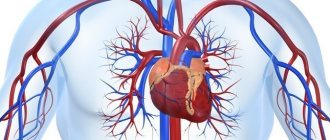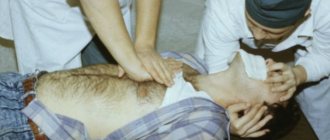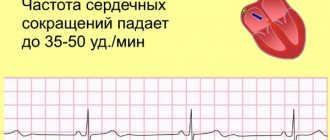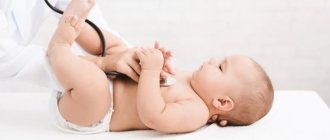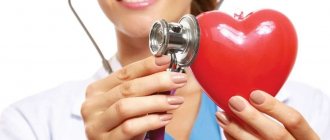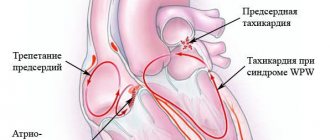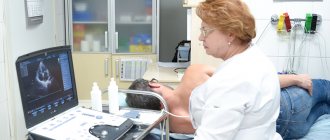Make an appointment by phone: +7 (343) 355-56-57
+7
- About the disease
- Cost of services
- Sign up
- About the disease
- Prices
- Sign up
Sinus arrhythmia (SA)
is an fluctuation in the rhythm of heart contractions emanating from the sinus node.
There is a conduction system in the human heart. It consists of nerve fibers, works on the principle of electrical wiring, and is responsible for ensuring that electrical impulses arise in the heart and are carried out to all its departments. This system is a kind of “battery”, since it is self-regulating and autonomous. In this self-regulating system there is an oscillation of the “current”. In humans, like in any living creature, fluctuations in the frequency and rhythm of heart contractions are possible.
The human heart is alive. It is impossible to artificially “set” its rhythm forever; this is not a household appliance, not a car.
The initiator of heart contraction is the sinus node. If “current fluctuations” occur at its level, then SA develops. It is not life-threatening, is usually secondary and goes away on its own.
Sinus arrhythmia can occur in anyone. During physical activity, emotions, both positive and negative, during sleep. But these deviations in heart rate are so short-term and insignificant that they are sometimes detected only during daily monitoring of the electrocardiogram; they do not require treatment, since they go away on their own, without symptoms.
Symptoms of arrhythmia
Manifestations of arrhythmia in a child may have different specifics. Each age group has its own characteristics. In newborns and infants, arrhythmia can manifest itself in the following symptoms:
- Refusal to eat.
- Slow growth.
- Intermittent sleep.
- Pallor.
- Dyspnea.
About half of all cases of arrhythmia in school-age children and adolescents are asymptomatic and are detected during routine medical examination.
In other cases, a sign of arrhythmia may be increased fatigue, exercise intolerance, pallor, decreased appetite, apathy, or, conversely, mild excitability. With a low heart rate, dizziness, pain in the heart area, and fainting may occur. Such manifestations require immediate intervention by specialists and hospitalization of the child. If you find similar symptoms in your child, make an appointment with our clinic specialists. Phone number for registration.
Heart rhythm disturbances in children
Posthypoxic complications of the cardiovascular system (CVS) in newborns range from 40 to 70% and represent an urgent problem in pediatric cardiology. In terms of frequency of occurrence, posthypoxic maladaptation states of the cardiovascular system are in second place after organic heart pathology in the neonatal period.
As a result of hypoxia in the fetus and newborn, the autonomic regulation of the heart and coronary circulation is disrupted, which can subsequently lead to the formation of persistent vegetative-visceral disorders, one of the manifestations of which is “posthypoxic syndrome of disadaptation of the cardiovascular system.”
What it is? This is a functional disorder of the cardiovascular system in a newborn and young child, which is associated with chronic antenatal (unfavorable course of pregnancy: long-term gestosis, threat of miscarriage, anemia during pregnancy, exacerbation of chronic diseases) and intranatal hypoxia (weakness of labor, premature birth, labor stimulation, cesarean section, umbilical cord entanglement). The clinical symptoms of this pathology are polymorphic, appear from the first days of life and are often disguised as other diseases. Therefore, the doctor has to carry out differential diagnosis with congenital heart defects, congenital carditis, and cardiomyopathies.
One of the common clinical variants of this syndrome in newborns is cardiac arrhythmia, most often in the form of supraventricular and ventricular extrasystole, rarely supraventricular paroxysmal tachycardia. These changes can occur even in the prenatal period and the first hours after birth.
The severity of the condition is usually due to hypoxic-traumatic damage to the central nervous system in the form of hyperexcitability syndrome, hypertensive-hydrocephalic and convulsive syndromes, impaired innervation of the heart, the condition of the myocardium (heart muscle) and hormonal status.
Extrasystole is a heartbeat that is premature in relation to the main rhythm. Depending on the location of the ectopic focus, atrial, atrioventricular and ventricular extrasystoles are distinguished. Depending on the location of the ectopic focus, atrial, atrioventricular and ventricular extrasystoles are distinguished. The problem of extrasystole attracts the attention of cardiologists due to its high prevalence and the possibility of sudden death. Ventricular extrasystole is considered the most unfavorable prognostically.
Are extrasystoles dangerous? Most arrhythmias in childhood are benign, reversible and do not pose a threat to the child’s life. In newborns and young children, they can lead to the development of arrhythmogenic cardiomyopathy or heart failure, contributing to early disability and even death. Ventricular extrasystole has an adverse effect on hemodynamics, causes a decrease in cardiac output and blood supply to the heart muscle, and as a result can lead to ventricular fibrillation and is associated with a risk of sudden death.
How do heart rhythm disturbances manifest? In approximately 40% of cases, rhythm disturbances in children are asymptomatic and are detected by chance (on an ECG), or during an objective examination during medical examination or after suffering viral or infectious diseases. Arrhythmias are manifested by palpitations, a feeling of interruptions in the work of the heart, and its freezing. In addition, the child may experience weakness, dizziness, fainting, shortness of breath, and periodically pale skin.
Examination plan for children with cardiac arrhythmias: 1. Assessment of clinical, anamnestic and genealogical data. 2. ECG examination (it is necessary to record a long ECG tape, since often NDCs are of an unstable nature and they do not have time to appear on a short tape). 3. Daily ECG monitoring. 4. Holter monitoring (HM) - long-term recording of an ECG (a day or more) on a special recorder, followed by decoding on a special analytical system. The method is available for any age, incl. and for newborn children. Today, the method is leading in the examination of children with disabilities. The uniqueness of the method is that ECG registration is carried out without restricting the patient’s free activity. The method has no contraindications. 3. Holter monitoring (HM) - long-term recording of an ECG (a day or more) on a special recorder, followed by decoding on a special analytical system. The method is available for any age, incl. and for newborn children. Today, the method is leading in the examination of children with disabilities. The uniqueness of the method is that ECG registration is carried out without restricting the patient’s free activity. The method has no contraindications. 3. Holter monitoring (HM) - long-term recording of an ECG (a day or more) on a special recorder, followed by decoding on a special analytical system. The method is available for any age, incl. and for newborn children. Today, the method is leading in the examination of children with disabilities. The uniqueness of the method is that ECG registration is carried out without restricting the patient’s free activity. The method has no contraindications. Ultrasound examination of the heart, or ECHO-cardiography (Echo-CG) 5. Consultation with a neurologist with NSG (neurosonography) and EEG (electroencephalography) of sleep 6. Consultation with an endocrinologist with an ultrasound of the thyroid gland and determination of hormonal status.
Principles of drug therapy for cardiac arrhythmias in children. Treatment of heart rhythm disturbances, especially life-threatening ones, is carried out strictly individually depending on their origin, form, duration, impact on the child’s well-being and the state of his hemodynamics. For all types of arrhythmias, cardiac and extracardiac causes should be treated simultaneously. Treatment should be comprehensive and include the prescription of neurometabolic, vascular drugs, cell membrane stabilizers and antioxidants. The interaction of these types of therapy makes it possible to ensure long-term remission and complete clinical recovery. There are situations when it is necessary to prescribe specialized antiarrhythmic therapy. Such changes include malignant arrhythmias and arrhythmogenic left ventricular dysfunction.
Clinical observation should be regular. Its frequency is determined depending on the underlying disease (rheumatism, non-rheumatic carditis, congenital heart disease, etc.), the form of arrhythmia and the characteristics of its course. Dynamic ECG recording and 24-hour ECG monitoring are required to assess the effectiveness of therapy.
Causes of arrhythmia
The causes of arrhythmia in a child are divided into several groups:
- Related to the work of the heart (cardiac causes).
These include congenital and acquired heart defects, carditis and cardiomyopathies, arterial hypertension, myocarditis, etc. This group also includes the consequences of severe infectious diseases such as tonsillitis, pneumonia, diphtheria. - Extracardiac causes.
These include diseases of the central nervous system, brain injuries and tumors, hereditary diseases, prematurity, complicated childbirth, etc. Conventionally, this group includes arrhythmia in adolescents, which is a consequence of the rapid growth of the body in conditions where the heart and blood vessels do not keep pace with the growth of muscles and skeleton.
Stages and signs
Sinus arrhythmia can also be classified based on the severity of the process.
Accordingly, three stages are distinguished:
- Soft or weak. Changes are minimal or completely absent, although organic damage to the heart already exists. Careful diagnostics are required to identify the problem. It exists in three named forms: tachycardia (over 110 beats per minute), bradycardia (less than 70 beats per minute), classic violation of the interval between contractions.
- Moderate sinus arrhythmia. Accompanied by pronounced deviations in the functional activity of the heart. The clinical picture is noticeable without diagnosis, but everything disappears quickly. Therefore, the patient does not have time to react. Increased rhythm - more than 120 beats. per minute Weakening - less than 60. Complications are not common, but are possible. You need to monitor your own condition.
- Severe sinus arrhythmia is the most dangerous type and can lead to cardiac arrest, heart attack, and complications. Heart rate is more than 140 or below 50.
Regardless of the type of pathological process, its stage, the symptoms are always the same, only the strength of expression differs. Some manifestations appear at later stages.
A sample list of symptoms is:
- Dyspnea. The patient lacks air, although there are no objective changes in the lungs and bronchi. The result of tissue hypoxia.
- Feeling of heartbeat. Both in the case of tachycardia and bradycardia.
- Discomfort in the chest and abdomen. Pressing and aching type, radiating to the arms and shoulder blades.
- Headache in the temporal region of a pulsating nature. Follows the beat of your heart.
- Vertigo. Vestibular phenomena are possible.
- Loss of consciousness, fainting, syncope.
- Weakness, drowsiness, problems with performance.
Signs of sinus arrhythmia are of cardiac and neurological origin, caused by tissue hypoxia and impaired cellular nutrition. Objectively, this is manifested by false reflex phenomena.
Diagnosis of arrhythmia
To make an accurate diagnosis, consultation with a pediatric arrhythmologist or pediatric cardiologist is necessary. The initial examination by a specialist includes:
- Studying the medical history.
- Carrying out a full examination (palpation, percussion, auscultation).
If an arrhythmia is suspected, the doctor will refer the child for instrumental diagnostics:
- Electrocardiography
is a universal method that allows you to evaluate the work of the heart in a specific time period. - Daily Holter monitoring.
A more accurate method compared to conventional electrocardiography, as it records the work of the heart over a long period of time (days), including sleep, physical activity, various periods of activity, etc. - Load tests.
This is an analysis of cardiac activity during physical activity of varying intensity.
This method can only be used with older children. After making a diagnosis, an arrhythmologist or pediatric cardiologist may prescribe examinations aimed at identifying the causes of the disease:
- EchoCG
(echocardiography or ultrasound of the heart). Allows you to identify organic causes of the disease, for example, heart defects, tumors, etc. - Radiography.
This method is aimed at identifying extracardiac causes of arrhythmia, for example, pathology of the spine, large vessels. - EEG.
Electroencephalography is indicated in cases of suspected connection of arrhythmia with brain diseases.
The SM-Doctor clinic for children and adolescents is equipped with only modern diagnostic equipment, which allows our specialists to make an accurate diagnosis and prescribe timely treatment for the disease.
The mechanism of development of sinus arrhythmia
The sinus node is a group of cells in the wall of the heart that produce an electrical impulse.
It is in the sinus node that a normal heartbeat impulse begins to form. It flows along fibers of the heart wall called the conduction system. This system diverges into many fibers, and the smallest of them end in each fiber of the heart wall. This mechanism ensures rhythmic and harmonious functioning of the heart (contractions occur at equal intervals, maintaining the optimal frequency within 60-90 per minute). It is the conduction system that ensures the correct sequence of contractions of the heart chambers. Failures in this system provoke the development of heart diseases, against the background of which heart rhythm disturbances develop.
According to the severity, this pathology is of two types - moderate and severe.
Moderate sinus arrhythmia is characterized by mild symptoms or occurs without obvious signs, and is more often recorded in childhood and adolescence.
Severe sinus arrhythmia is more common in older people, is characterized by obvious clinical manifestations, and is combined with various diseases.
Treatment of arrhythmia
Treatment methods for arrhythmia in children depend on the causes and variant of the identified disorders.
Only an arrhythmologist (pediatric cardiologist) makes a decision on the need to treat arrhythmia. Self-treatment of the disease is strictly prohibited. This threatens the child with complications and the development of dangerous symptoms. However, given the often asymptomatic nature of many rhythm disturbances, including life-threatening ones, parents themselves should pay great attention to the problem.
To make an appointment with children's ari, fill out the online form or call us at +7 (495) 292-59-86.
Prevention of the disease
Preventive measures to prevent the occurrence of arrhythmia will not be superfluous either for children with heart rhythm disturbances or for absolutely healthy children.
First of all, irritating factors should be eliminated, concomitant diseases that can increase the load on the heart should be thoroughly treated, and routine examinations of the functioning of the cardiovascular system should be periodically carried out.
Along with visiting a pediatric cardiologist, it may be necessary to visit a pediatrician, pediatric endocrinologist, hematologist and rheumatologist.
In addition, it is important to protect the child from hypothermia, to prevent the development of chronic foci of all kinds of infections, and to avoid viral diseases as much as possible.
Strengthening natural immunity is of great importance, which requires:
- establish proper sleep;
- take care of a rational, balanced diet with sufficient content of all necessary vitamins and minerals;
- maintain a water regime: drink daily the norm of clean water established by age;
- carry out gradual hardening;
- spend time in the fresh air as often as possible;
- reduce the level of stress (especially important for schoolchildren).
In the fight for good health of the child’s cardiovascular system, one method, in most cases, is not enough. Often it is necessary to resort to both medication and preventive measures. It is extremely important not to stop there, and even after the arrhythmia is defeated, to maintain a healthy daily routine.
Arrhythmia in adolescents
Arrhythmia in adolescence is usually not associated with any pathology, but is a feature of the transition period.
In adolescent children, the most common conditions are:
- Respiratory arrhythmia is a typical teenage arrhythmia. When you inhale, the heart rate increases somewhat, and when you exhale it slows down. Such irregularity of heart rhythm indicates increased excitability of the autonomic nervous system and for a teenager this is the norm, while the appearance of respiratory arrhythmia in an adult is a symptom of the disease.
- Extrasystoles are sudden, extraordinary contractions of the heart. Usually they are not felt by a person, but are detected on an ECG. Extrasystoles in adults are a pathology, and in adolescence they can be a variant of the norm. Such cardiac arrhythmia in adolescents occurs due to increased growth of the heart.
Types of arrhythmia in children and adolescents
1. Arrhythmias due to impulse formation disorder:
- sinus bradycardia is a decrease in heart rate compared to normal age-related rates;
- sinus arrhythmia
– may be associated with breathing (respiratory) or not;
- sinus tachycardia is an increase in heart rate that exceeds age norms;
| Child's age | Normal heart rate, beats/min. |
| Newborns | 110–170 |
| Up to a year | 102–162 |
| 1–2 years | 94–154 |
| 3–4 years | 90–140 |
| 5–6 years | 86–126 |
| 7–8 years | 78–126 |
| 9–10 years | 68–108 |
| 11–12 years old | 60–100 |
| 13–15 years old | 55–95 |
- pacemaker migration – change in the source of impulse formation;
- extrasystole - premature contraction of the heart, can be supraventricular or ventricular;
- paroxysmal and non-paroxysmal (constant) tachycardia: supraventricular and ventricular;
- atrial flutter is a significantly accelerated, but correct, regular contraction of the atria with a frequency of 250–300 per minute;
- atrial fibrillation – atrial contraction 400–700 per minute;
- ventricular flutter - their contraction with a frequency of 250–300 per minute;
- ventricular fibrillation (fibrillation) – chaotic rhythm (frequency – up to 400 or more per minute).
2. Arrhythmias provoked by impaired impulse conduction:
- Atrioventricular (AV) blocks;
- Intraatrial blocks;
- Intraventricular blocks;
- Sinoatrial (SA) block;
3. Combined arrhythmias:
- Atrioventricular dissociation;
- Sick sinus syndrome;
- Ventricular preexcitation syndrome.
Diagnosis of heart rhythm disorders in children
Cardiac arrhythmia in a child and its nature will be determined using an ECG examination, which is carried out not only if cardiac pathology is suspected or if there are “heart” complaints, but also for other childhood diseases.
ECG can successfully detect pathological arrhythmias (complete AV block, atrial fibrillation
) or arrhythmias that are a variant of the norm for children (incomplete block of the right bundle branch - RBBB, sinus respiratory arrhythmia in children).
However, to make a correct diagnosis and find out the causes of arrhythmia, a comprehensive examination is necessary:
- Studying the child’s medical history, morbidity in the family;
- Electrocardiography;
- X-ray examination of the chest organs;
- Holter monitoring – long-term ECG recording;
- Stress tests (treadmill test);
- Drug electrocardiographic tests;
- Neurophysiological studies (EEG), rheoencephalography;
- Echocardiographic examination (ECHO-CG).


